Pueraria tuberosa: A Review on Traditional Uses, Pharmacology, and Phytochemistry
- PMID: 33708108
- PMCID: PMC7941752
- DOI: 10.3389/fphar.2020.582506
Pueraria tuberosa: A Review on Traditional Uses, Pharmacology, and Phytochemistry
Abstract
Pueraria tuberosa (Roxb. ex Willd.) DC. (Fabaceae), also known as Indian Kudzu (vidari kand), is a perennial herb distributed throughout India and other Asian countries. Traditionally, tuber and leaves of this plant have extensively been reported for nutritional and medicinal properties in Ayurveda as well as in Chinese traditional practices. The objective of the present review is to compile and update the published data on traditional uses, pharmacological potential, and phytochemistry of compounds isolated from the plant Pueraria tuberosa. P. tuberosa extracts and its purified compounds possess multiple activities such as anticancer, anticonvulsant, antidiabetic, antifertility, anti-inflammatory, antioxidant, anti-stress, antiulcerogenic, cardioprotective, hypolipidemic, hepatoprotective, immunomodulatory, nephroprotective, nootropic, neuroprotective, and wound healing. Tuber and leaf extracts of P. tuberosa contain several bioactive constituents such as puerarin, daidzein, genistein, quercetin, irisolidone, biochanin A, biochanin B, isoorientin, and mangiferin, which possess an extensive range of pharmacological activities. The extensive range of pharmacological properties of P. tuberosa provides opportunities for further investigation and presents a new approach for the treatment of ailments. Many phytochemicals have been identified and characterized from P. tuberosa; however, some of them are still unexplored, and there is no supporting data for their activities and exact mechanisms of action. Therefore, further investigations are warranted to unravel the mechanisms of action of individual constituents of this plant.
Keywords: Pueraria tuberosa; in vivo studies; pharmacological properties; phytochemical constituents; traditional uses.
Copyright © 2021 Bharti, Chopra, Raut and Khatri.
Conflict of interest statement
The authors declare that the research was conducted in the absence of any commercial or financial relationships that could be construed as a potential conflict of interest.
Figures





Similar articles
-
Pueraria tuberosa: a review on its phytochemical and therapeutic potential.Nat Prod Res. 2014;28(23):2111-27. doi: 10.1080/14786419.2014.928291. Epub 2014 Jul 1. Nat Prod Res. 2014. PMID: 24980468 Review.
-
A fraction of Pueraria tuberosa extract, rich in antioxidant compounds, alleviates ovariectomized-induced osteoporosis in rats and inhibits growth of breast and ovarian cancer cells.PLoS One. 2021 Jan 14;16(1):e0240068. doi: 10.1371/journal.pone.0240068. eCollection 2021. PLoS One. 2021. PMID: 33444328 Free PMC article.
-
Isoflavonoids production in callus culture of Pueraria tuberosa, the Indian kudzu.Indian J Exp Biol. 2006 Dec;44(12):1012-7. Indian J Exp Biol. 2006. PMID: 17176676
-
Ethnomedicinal Uses, Phytochemistry, Pharmacology, and Toxicology of Ruellia tuberosa L.: A Review.Chem Biodivers. 2024 Aug;21(8):e202400292. doi: 10.1002/cbdv.202400292. Epub 2024 Jul 26. Chem Biodivers. 2024. PMID: 39056380 Review.
-
Gmelina arborea- an indigenous timber species of India with high medicinal value: A review on its pharmacology, pharmacognosy and phytochemistry.J Ethnopharmacol. 2021 Mar 1;267:113593. doi: 10.1016/j.jep.2020.113593. Epub 2020 Nov 18. J Ethnopharmacol. 2021. PMID: 33217516 Review.
Cited by
-
Effect of Biotic Elicitors on the Growth, Antioxidant Activity and Metabolites Accumulation in In Vitro Propagated Shoots of Pueraria tuberosa.Plants (Basel). 2023 Mar 14;12(6):1300. doi: 10.3390/plants12061300. Plants (Basel). 2023. PMID: 36986988 Free PMC article.
-
Structural characterization, anti-inflammatory and glycosidase inhibitory activities of two new polysaccharides from the root of Pueraria lobata.RSC Adv. 2021 Nov 8;11(57):35994-36006. doi: 10.1039/d1ra07385k. eCollection 2021 Nov 4. RSC Adv. 2021. PMID: 35492792 Free PMC article.
-
The mechanistic study of quercetin in the treatment of alcoholic brain injury via the JNK/P38 MAPK signaling pathway.Apoptosis. 2025 Aug;30(7-8):1875-1892. doi: 10.1007/s10495-025-02125-w. Epub 2025 Jun 2. Apoptosis. 2025. PMID: 40457147
-
Fabrication of zinc oxide nanoparticles using Ruellia tuberosa leaf extract induces apoptosis through P53 and STAT3 signalling pathways in prostate cancer cells.Open Life Sci. 2025 Jul 11;20(1):20251121. doi: 10.1515/biol-2025-1121. eCollection 2025. Open Life Sci. 2025. PMID: 40667484 Free PMC article.
-
Effect of Dietary Puerarin Supplementation on Growth Performance, Immune Response, Antioxidant Capacity, and Intestinal Morphology in Domestic Pigeons (Columba livia).J Poult Sci. 2024 Jan 26;61:2024003. doi: 10.2141/jpsa.2024003. eCollection 2024. J Poult Sci. 2024. PMID: 38283163 Free PMC article.
References
-
- Adedapo A. A., Fagbohun O. A., Dawurung C., Oyagbemi A. A., Omobowale T. O., Yakubu M. A. (2017). The aqueous tuber extract of Pueraria tuberosa (Willd.) D.C. caused cytotoxic effect on HT 29 cell lines with down regulation of nuclear factor-kappa B (NF-κB). J. Compl. Integr. Med. 16 (4), 1–8. 10.1515/jcim-2016-0119 - DOI - PubMed
-
- Aruna M. R., Kumar D. J. M., Senbagam D., Senthilkumar B. (2016). Investigation on phytochemical and antimicrobial properties of tuber extracts of pueraria tuberosa linn. J. Pure Appl. Microb. 10 (2), 1573–1578.
Publication types
LinkOut - more resources
Full Text Sources
Other Literature Sources

